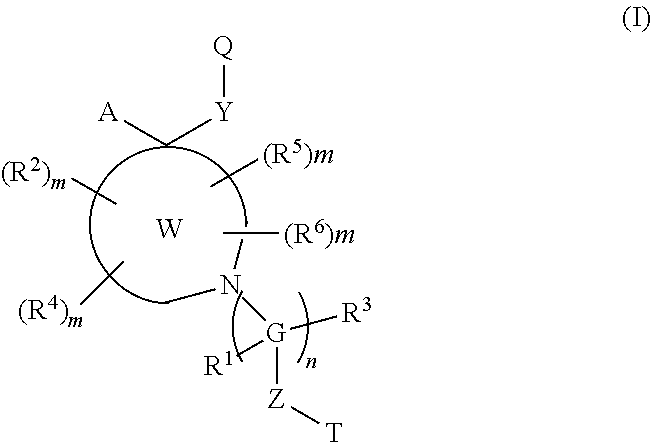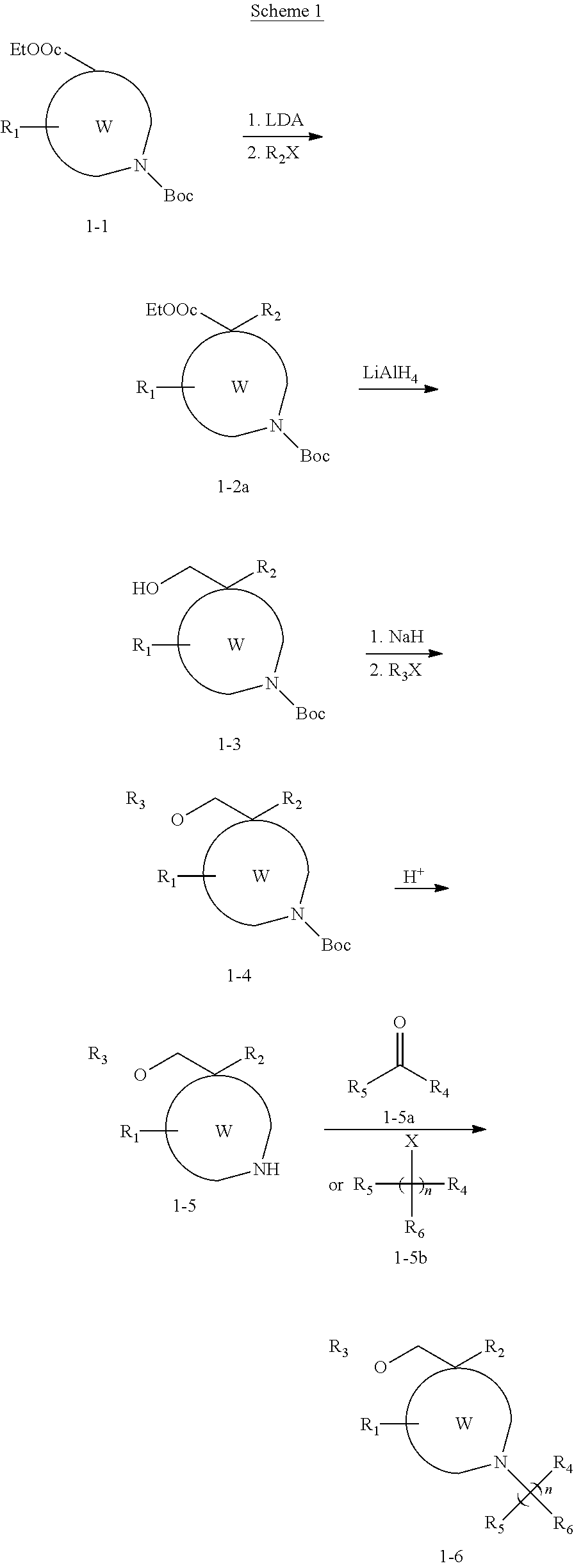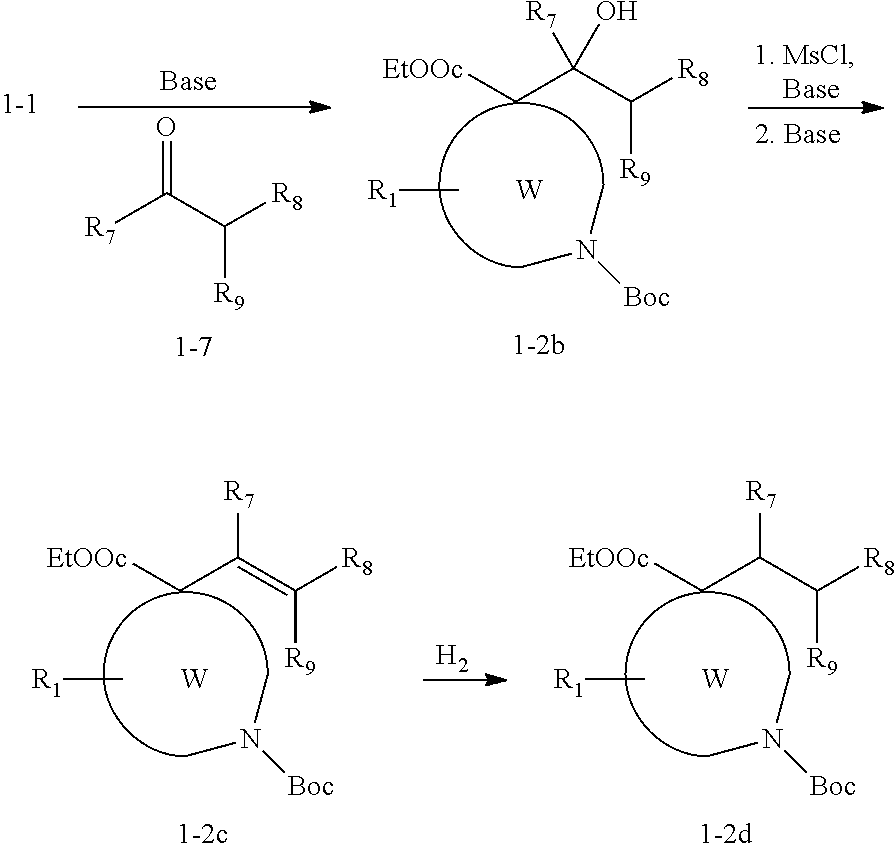Polycyclic amines as opioid receptor modulators
a technology of polycyclic amines and opioid receptors, applied in the field of polycyclic amines, can solve problems such as limiting usefulness
- Summary
- Abstract
- Description
- Claims
- Application Information
AI Technical Summary
Benefits of technology
Problems solved by technology
Method used
Image
Examples
example 1
1. Synthesis of N-(4-((3-(ethoxymethyl)-3-phenethylpyrrolidin-1-yl)methyl)phenyl)acetamide
[0130]
1.1 Preparation of 1-tert-butyl 3-methyl 3-phenethylpyrrolidine-1,3-dicarboxylate
[0131]To a solution of LHMDS (193.4 mL, 193.4 mmol, 1 M in THF solution) in anhydrous THF (350 mL) under N2 atmosphere at −78° C. was added dropwise a solution of (2-iodoethyl)benzene (44.87 g, 193.4 mmol) and 1-tert-butyl 3-methyl pyrrolidine-1,3-dicarboxylate (22.2 g, 96.7 mmol) in anhydrous THF (350 mL) over 1.5 h. After the completion of addition, the mixture was stirred at −78° C. for 1 h, followed by stirring at −40° C. for 3 h before it was warmed to RT and stirred overnight. Upon completion of the reaction, the reaction was quenched with aqueous NH4Cl and the resulting mixture was extracted with EtOAc. The organic layer was separated, washed with brine, and dried over anhydrous Na2SO4. After filtration and concentration under reduced pressure, the crude product was purified by silica-gel column chroma...
example 2
Antinociception and Hot Plate Test
Animals
[0357]Male Sprague Dawley rats (200 g˜300 g) were maintained on a 12-hourlight / dark cycle with Purina rodent chow and water available ad libitum, and they were housed in groups of two until testing.
Hot Plate Test
[0358]The hot plate test is adapted from that described previously (Tyers, 1980). Male Sprague-Dawley rats (200-300 g) were acclimated to the vivarium for 48 hours. Animals were placed individually on a heated surface (52° C.) and the time interval (seconds) between placement and a licking of the hind paw was recorded as the predrug latency response. This same procedure was repeated 30 minutes after s.c. administration of a compound. All compounds were administered s.c. in a volume of 2 ml / 100 g. The cutoff time, designed to prevent injury to the animals, was 30 seconds (with vehicle latencies of approximately 8-15 seconds). The percent maximum possible antinociceptive effect [% maximum possible effect (MPE)] was determined using the ...
example 3
Antinociception and Warm-Water Tail-Flick Test
Animals
[0360]Male C57BL / 6 mice (20-30 g; 6-12 wk) were maintained on a 12-h light / dark cycle with rodent chow and water available ad libitum, and they were housed separately until testing.
Warm-Water Tail-Flick Test
[0361]Antinociception was assessed using the 55° C. warm-water tail-flick test. The latency to the first sign of a rapid tail flick was taken as the behavioral endpoint (Jannsen et al., 1963). Each mouse was first tested for baseline latency by immersing its tail in the water and recording the time to response. Mice not responding within 2 s were excluded from further testing. Mice were then s.c. administered the test compound and tested for antinociception at 30 min, 60 min, 90 min, and 120 min time points afterward. Antinociception was calculated using the following formula: percentage of antinociception=100×(test latency−control latency) / (20−control latency). To avoid tissue damage, a maximum score was assigned (100%) to ani...
PUM
 Login to View More
Login to View More Abstract
Description
Claims
Application Information
 Login to View More
Login to View More - R&D
- Intellectual Property
- Life Sciences
- Materials
- Tech Scout
- Unparalleled Data Quality
- Higher Quality Content
- 60% Fewer Hallucinations
Browse by: Latest US Patents, China's latest patents, Technical Efficacy Thesaurus, Application Domain, Technology Topic, Popular Technical Reports.
© 2025 PatSnap. All rights reserved.Legal|Privacy policy|Modern Slavery Act Transparency Statement|Sitemap|About US| Contact US: help@patsnap.com



